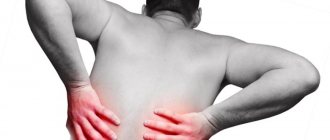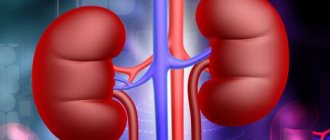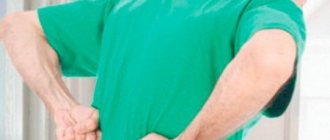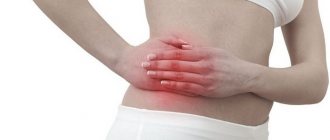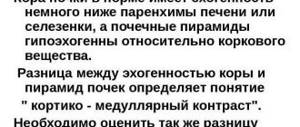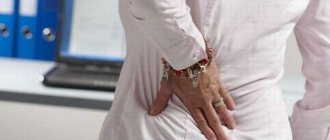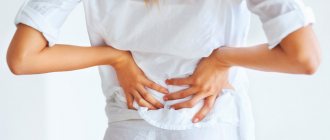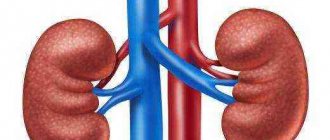When inhaling, the back hurts in the kidney area
Painful sensations when inhaling or exhaling are not that uncommon.
But, according to statistics, only 6% of pain is caused by kidney disease. Pain, whatever it may be, is only a symptom, a sign that the functioning of organs is disrupted in some part of the body. However, it is almost impossible to determine which organs were affected and for what reasons only by the location of the pain and its nature.
When talking about pain in the kidney, when you sigh, it makes sense to mean pain in the lumbar region when you sigh.
Kidney pain when inhaling
First of all, such pain can be two- or one-sided. In this case, the first thing that comes to mind is some form of kidney inflammation on one or both sides. The pain is uncharacteristic, it can be acute, nagging, paroxysmal and change completely differently over time.
The most common symptoms are:
- pain when inhaling or exhaling deeply in the kidney area, most often the former. There is no dependence on the time of day;
- pain when coughing;
- pain syndrome that appears or intensifies during physical activity on the right or left - fast walking, running, dancing;
- pain associated with the time of day - at night, only in the morning, and so on.
Such diverse symptoms are obviously associated with different causes and the kidneys, as practice shows, are far from the most common of them.
How are these organs connected to breathing? At first glance, there is no relationship between their work, and this is absolutely true. However, there is a mechanical connection associated with the location of the organs. The kidney is a somewhat mobile organ.
The kidney is held in place by the ligamentous apparatus. If it is damaged, the organ begins to move chaotically and turn over—the “wandering kidney” syndrome. Such displacements, intensified by deep breathing, cause painful sensations.
The relationship between breathing and sensations in the kidney area
How to recognize kidney pain
However, other diseases can have almost the same symptoms, so recognizing what exactly hurts can be very difficult. According to statistics, 90% of such pain is associated with diseases of the spine, 6% with the kidneys, and 4% are due to other ailments.
However, by some signs it is possible to determine what exactly caused the painful syndrome or what form indicates other diseases:
- So, if pain coincides with limited mobility or subsides with the use of warming and anti-inflammatory connections, and if only the right or left kidney hurts, we can say with confidence that the kidneys have nothing to do with it.
- The organs are located on both sides of the spine and slightly above the lower back. Therefore, if the pain syndrome is localized in the center or below the lower back, then its cause is some other injury.
- Kidney problems are often accompanied by characteristic swelling in the morning: first there is swelling under the eyes, a little later the face swells, and then the limbs.
- More severe stages of kidney damage are accompanied by cloudy urine, the appearance of a drop of blood in it, unusual distribution of urine - for example, more urine is released at night than during the day, and so on.
- Pain when urinating, increased blood pressure is a fairly characteristic symptom in combination with pain in the kidney area when inhaling.
- Kidney diseases can be accompanied by visual impairment, the appearance of skin rashes, as a result of intoxication of the body. But, as a rule, at this stage the pain is localized very clearly and accompanies not only inhalation, but is constant.
- It is important to pay attention to previous circumstances. If before the onset of the symptom the patient performed heavy and unusual physical work, then the problem is most likely in the muscles. And if before this there was hypothermia or wet feet, then inflammation of the kidney is a more likely cause.
- The Pasternatsky test is quite effective - up to 70%. When tapping in the area where the kidneys are located, painful sensations occur.
Of course, the final diagnosis of why the kidneys hurt when you inhale is made by a doctor, and, as a rule, more than one. However, a preliminary conclusion, albeit an independent one, is also important. The fact is that the usual method of treatment for muscle strains or osteochondrosis - which is incorrect, but at least safe - is to warm up the lower back.
If the cause of the pain syndrome is inflammation of the kidneys, this should not be done under any circumstances. During inflammation, the kidney tissue swells, the kidney capsule, which is rich in nerve endings, stretches. This stretching leads to pain.
When this area is heated, the swelling will increase, which, accordingly, will only worsen the patient’s condition.
Possible reasons
All possible causes are divided into primary, associated with diseases of the spine, and secondary, caused by ailments of the internal organs.
- Osteochondrosis - not only of the lumbar, but also of the thoracic region, is the most common cause of various lower back pain, including those that are mistaken for renal colic. The fact is that with this disease, blood circulation in the muscles around the spinal column is disrupted; accordingly, the latter ceases to receive nutrition in the required amount, which leads to damage and destruction of the cartilage between the vertebrae. In turn, the reduction of cartilage blocks the mobility of the entire spine, leads to swelling and spasms of the surrounding muscles, and, therefore, to compression of the nerve fibers and their damage.
It is not so easy to separate this syndrome from renal colic, since swelling of the muscle tissue also affects the position of the kidney. And squeezing the tissues around the organ quite successfully simulates pain during inflammation.
- Intercostal neuralgia - causes very severe pain when inhaling or exhaling. If the sensations are localized not in the chest area, but in the lumbar region, this syndrome can be confused with a sign of kidney inflammation. However, it is not accompanied by any changes in the urine, does not provoke an increase in pressure or temperature, but only noticeably limits mobility.
- Gallstone disease - its clinical picture is very diverse and includes renal, hepatic colic, and dyspepsia. In this case, a diagnosis can only be made after hardware diagnostics.
- Pancreatitis - chronic or asymptomatic, is accompanied by a dull aching pain that intensifies with inspiration, although the latter is not a characteristic sign. However, most often such sensations appear after eating or drinking alcohol, which is quite easy to notice. In addition, the pain quickly becomes irritating.
Source: https://mybabic.com/info/pri-vdohe-bolit-spina-v-oblasti-pochek/
Drug treatment
We will tell you about all existing types of drug therapy. Before using this or that drug, consultation with a specialist is required.
Non-narcotic and narcotic analgesics
Analgesics help eliminate pain of any etiology, including in the back. Non-narcotic analgesics are safe for a short course of treatment:
- Analgin – from 20 rub.
- Aspirin – 15 rub.
- Baralgin M – from 285 rub.
Baralgin M is a good analgesic for back pain - Solpadein Fast - from 160 rub.
- Efferalgan – from 205 rub.
Narcotic analgesics contain substances that completely suppress pain. They are prescribed when non-steroidal anti-inflammatory drugs and hormonal agents do not help. Narcotic analgesics are dispensed strictly according to prescription.
List of drugs:
- Tramadol;
- Vicodin;
- Codeine;
- Fentanyl;
- Morphine;
- Promedol.
Nonsteroidal anti-inflammatory drugs (NSAIDs)
Such drugs are prescribed first. NSAIDs suppress inflammation and pain. They can be used for no more than 10 days, otherwise various side effects may develop, such as stomach pain.
For severe pain, injections are prescribed and then transferred to tablets. Increasing dosages does not reduce pain.
- Diclofenac (analogs: Voltaren, Diclovit, Ortofen, Dolaren, Diclak) – from 20 rub.
- Arcoxia. Contains a substance called etoricoxib, which helps even with a single tablet. Costs from 405 rub.
- Meloxicam (analogs: Amelotex, Movalis, Artrosan). A new generation NSAID has good efficacy and few side effects. Costs from 75 rub.
Artrosan is a relatively safe NSAID for back pain - Ketonal (analogues: Artrosilene, Bystrumkaps, Flamax). Contains ketoprofen. Price from 110 rub.
- Ketorolac (analogues: Ketorol, Ketanov). The most powerful NSAID, but can cause severe side effects. Costs from 50 rubles.
- Ibuprofen. A good and safe remedy in a short course. Costs from 30 rubles.
- Lornoxicam. Highly effective product. Costs from 210 rub.
- Nise (analogues: Nimesil, Nimesulide, Nimika). A good, relatively safe NSAID. Costs from 220 rub.
- Dilaxa (analogue – Celecoxib). A new generation NSAID that can eliminate even chronic pain. Costs from 210 rub.
Muscle relaxants
These are drugs that relax the back muscles. In combination with NSAIDs they give a good effect. They should only be prescribed by the attending physician.
- Sirdalud – from 260 rub.
- Mydocalm - from 410 rub.
Mydocalm relieves muscle spasms well - Tizalud - from 180 rub.
- Baklosan – from 310 rub.
- Tizanidine – from 165 rub.
Hormonal glucocorticosteroids
These are products containing the human hormone cortisol. They help in severe cases when NSAIDs do not help. They are allowed to be used no more than once a year due to serious side effects.
- Methylprednisolone (analogue - Metipred) - from 210 rub.
- Kenalog – from 360 rub.
Kenalog is an effective corticosteroid - Cortisone – from 910 rub.
- Dexamethasone – from 60 rub.
- Diprospan - from 230 rub.
Novocaine blockades
These are special injections that are given at trigger (pain) points or in the area between the vertebrae (epidural blockades). The injection contains Novocaine + glucocorticosteroid (Diprospan, Dexamethasone). Provides a rapid analgesic effect compared to other forms of drugs.
Therapeutic blockades should be administered by an experienced doctor.
B vitamins
This is an important component of treatment. Such vitamins improve the condition of nerve roots and prevent exacerbations of diseases. They are often prescribed along with muscle relaxants and NSAIDs.
- Combilipen - from 180 rub.
- Milgamma – from 310 rub.
Milgamma helps restore the nervous system - Neurobion - from 300 rub.
Be sure to read this good article:
TOP 100 drugs for pain in the back, lower back and joints: painkillers, injections, suppositories, ointments, patches
Chondroprotectors
Help restore cartilage tissue in joints and intervertebral discs. Must be used for at least 3 months. Some neurologists doubt the effectiveness of chondroprotectors.
- Don - from 1350 rub.;
- Chondrolon - from 150 rubles;
- Mukosat – from 700 rub.;
- Alflutop – from 1700 rub.
Homeopathy
The composition includes plant components. At the beginning of use, exacerbation of diseases is possible. Activates the internal forces of the body. Use with caution after consultation with a specialist.
- Traumeel S – from 150 rub.
- Target T – from 470 rub.
- Rus-Plus - from 350 rub.
- Discus compositum – from 1350 rub.
Combined painkillers
Such medicines contain several active substances at once.
- Katadolon Forte. It has the properties of non-steroidal anti-inflammatory drugs and muscle relaxants. Price from 910 rub.
Katadolon Forte can help even with severe pain - Panoxen – 160 rub.
- Neurodiclovit – from 310 rub.
- Next – from 175 rub.
Candles
These are rectal suppositories that are inserted into the anus. They are prescribed to those patients for whom tablets and injections are contraindicated. Suppositories have fewer side effects. The approximate course of therapy is five days.
- Diclovit – from 175 rub.
- Voltaren - from 305 rub.
Voltaren in the form of suppositories - Ketonal – from 270 rub.
- OKI - from 300 rub.
- Diclofenac – from 50 rub.
Good article to follow up:
TOP 50+ best pain-relieving suppositories for pain in the back, lower back and joints
Ointments
They are recommended to be used together with tablets and injections to enhance the therapeutic effect. Sometimes they even help reduce the number of medications used.
The ointment should be rubbed in three times a day for 1-2 weeks.
If inflammation is present, warming ointments cannot be used.
Warming ointments:
- Nicoflex - from 360 rubles;
- Kapsikam - from 3750 rub.;
- Finalgon - from 385 rub.
These ointments must be applied using an applicator.
Pain-relieving ointments contain NSAIDs and other medicinal components:
- Ketoprofen - from 110 rubles;
- Bystrumgel - from 260 rubles;
- Ortofen - from 165 rub.
- Voltaren emulgel – from 250 rub.
- Diclofenac - from 55 rub.
Diclofenac - an inexpensive ointment for inflammation and back pain - Fastum gel - from 2850 rub.;
- Amelotex – 205 rub.
- Diclovit - from 165 rubles;
- Dolobene - from 490 rubles;
- Apizartron - from 330 rubles;
- Dolgit (Ibuprofen) – 110 rub.
- Viprosal B - from 380 rub.
- Ketonal - from 430 rubles;
- Nise - from 280 rub.
Plasters
This is a more convenient form of medication. It is necessary to stick the patch on previously cleansed skin. The product must be kept for 12 hours to 3 days, depending on the drug.
- Voltaren – contains diclofenac. Valid for 24 hours. Price – from 290 rub.
- Versatis. Contains lidocaine. Valid for 12 hours. Costs from 950 rub.
How to determine if your kidneys or back hurt: home remedies
The kidneys are located closer to the back surface of the abdominal cavity, so kidney pain is easily confused with diseases of the spine. There are several solutions to the question of how to determine whether your kidneys or back hurt. Pain of renal origin can be distinguished by a significant deterioration in well-being, frequent urge to go to the toilet, bouts of vomiting, and an increase in body temperature.
Can your kidneys hurt?
Due to various diseases and abnormalities, the kidneys really hurt. The sensations associated with kidney disease may resemble those experienced by a person suffering from osteochondrosis or radiculitis. Discomfort in the back spreads to the lower half, is felt in the area of the kidneys, extends to the thigh, groin area.
Abnormal mobility of the kidney, in which it descends, is called nephroptosis.
Stress is blamed for surges in blood pressure during nephroptosis, dull nagging pain is often attributed to osteochondrosis, and recurring inflammation is attributed to colds.
The lower back may hurt due to the kidneys on one or both sides.
In most cases, the cause of pain is inflammation - pyelo-, glomerulonephritis, displacement of stones due to impaired salt metabolism.
How to determine if your kidneys are hurting
In addition to painful sensations, there are other signs that accompany pathological processes in the kidneys. Knowing them, you can correctly determine, even at home without the help of doctors, that the pain is caused precisely by problems with the kidneys.
Nature of pain
The way pain of renal origin manifests itself depends on the pathology that caused it. Inflammation of the kidney can be recognized by dull pain and heaviness in the lower back. It occurs due to swelling and stretching of the kidney capsule. The membrane is equipped with many nerve endings, which are irritated and cause pain during pyelonephritis.
Cutting pain in the kidney area in women and men due to renal colic is simply explained. It is due to the fact that the calculus blocks the lumen of the ureter. As a result, the outflow of urine worsens or becomes completely impossible.
The sharp edges of the stones damage the tissue and nerve endings inside the ureter. This is another cause of stabbing pain.
You can distinguish pain of renal origin from sore back muscles by intensity.
Muscle pain from dull, aching can change to acute (if you act on the muscles at the source of excitation) or fade away against the background of absolute rest. With kidney pathology, the pain is constant and intensifies during rest.
Localization
By where the pain is felt with the greatest intensity, you can also understand whether it is associated with kidney problems or is it a manifestation of radiculitis. In the first case, lower back pain in men and women is more often one-sided and comes from the depths of the lower part of the body. When only the surface of the back hurts, the discomfort is not related to the kidneys.
Radiation of pain
You can conclude whether your back or kidneys hurt based on the distribution of discomfort on:
- inner thigh;
- groin area;
- lower abdomen.
These symptoms, as well as pain along the ureter, indicate a kidney failure.
Problems of the musculoskeletal system cause muscle pain, which radiates to the lower back, sacrum, and buttocks.
Pain and mobility
Pain in the lower back or kidneys during movement is different. If the cause is muscle tension or inflammation, then discomfort occurs when a person tries to change body position. Often with osteochondrosis or rheumatism, it is not possible to straighten up or bend over.
Kidney pain forces you to look for a comfortable position. While standing, a person experiences severe pain, and lying on his back, turning on his side or getting on all fours, he feels relief.
Response to tapping
You can find out whether your kidneys or lower back hurt by tapping:
- An open palm is applied to the place where the kidneys are projected (the paravertebral region under the lower ribs).
- The second palm is clenched into a fist and lightly tapped on the hand attached to the body.
- Tapping can be done with the edge of the palm or fingertips.
- Kidney pathology is indicated by pain that occurs when shaking.
A person with back pain cannot perform tapping on their own. For this he needs an assistant.
What preceded the pain?
Before determining whether the lower back or kidneys hurt, it is necessary to find out the circumstances that led to the illness. Unusual physical activity - housework, intensive training or exercise without prior warm-up - can cause muscle spasms.
Pinched nerve roots, disc displacement, and spinal hernia can occur due to heavy lifting after an unsuccessful fall. You can find out that it is the kidneys that are hurting if a person is very cold, has bathed in a pond with cold water, or has recently had an acute respiratory viral infection or a sore throat.
Additional signs that your kidneys are hurting, not your back
If the kidneys hurt, then other symptoms appear. The temperature rises sharply (with inflammation up to 39.5-40°C). In the morning, swelling is noticeable, especially on the face, but serious pathologies provoke fluid retention throughout the body. Towards the end of the day, renal edema disappears.
Taking a closer look at the urine, you can notice impurities - blood, pus. In the first case, the cause is tissue trauma during the movement of stones, dysfunction of the renal structures, in the second - an extensive inflammatory process.
Urination becomes more frequent than usual. It is accompanied by burning pain. This is one of the signs of sand movement in urolithiasis.
Kidney pathologies are often associated with pressure surges - special attention should be paid to this. Fluid stagnation due to kidney pathologies provokes self-poisoning. Against this background, sleep disturbances, attacks of nausea, and vomiting occur. These symptoms never accompany back pain caused by spinal or muscular problems.
Characteristic symptoms of back pain
With pain of non-renal origin, the muscles seem to go numb, a slight tingling or goosebumps are felt.
Relief occurs if you rub the sensitive surface with a warming gel (Apizartron, Capsicam), ointment with a non-steroidal anti-inflammatory component (Voltaren Emulgel, Diclofenac, Naproxen, Ibuprofen), take a medicine based on NSAIDs (Diclofenac, Diclak) orally or use a rectal suppository (Dicloberl).
Kidney back pain is not relieved by ointments and rubbing. To slightly alleviate the sharp pain during stone movement, it is recommended to take a warm bath or apply a heating pad to the lower back. The heat will relax the muscles and eliminate spasms.
Medicines containing diclofenac do not help with kidney pain. The unpleasant sensations subside a little after taking antispasmodics - Baralgin, Spazgan, No-shpa, Papaverine.
What tests are needed for kidney and lumbar pain?
To cure back pain, self-diagnosis is not enough. The cause can only be eliminated by undergoing a full examination:
- General clinical analysis of blood and urine. In case of renal pathologies, the result of a urine test will show an excess of leukocytes (due to inflammation), red blood cells, excessive amounts of salts (due to urolithiasis), purulent and mucous impurities. High ESR, leukocytosis, and often low hemoglobin levels are detected in the blood.
- Urine samples using the Nechiporenko and Zimnitsky method help confirm pyelo- and glomerulonephritis.
- To identify the causative agent of inflammation, urine culture is prescribed, and the reaction of the cultured microorganism to antibacterial agents is immediately checked.
- An abdominal ultrasound is performed to assess the condition of the kidneys, their size, the presence of foci of inflammation, purulent accumulations, stones, and sand. The peculiarities of the location of the paired organ are also revealed. The kidneys are scanned first while lying down, and then when the patient is standing (to detect nephroptosis).
- Additionally, a tomography is prescribed (if the doctor suspects a tumor in the kidney).
- To diagnose the location of stones, an X-ray examination is performed with intravenous contrast (excretory urography).
- Additionally, tomography may be prescribed (detects vertebral hernias and other formations).
The cause of lower back pain is determined based on an X-ray examination, examination by an orthopedist or neurologist.
Source: https://simptom.info/nefrologiya/kak-opredelit-bolyat-pochki-ili-spina
Folk remedies
You can relieve discomfort with the help of folk remedies. In folk medicine there are many recipes for various infusions, decoctions and teas that will eliminate the problem in men and women. It is recommended to prepare a decoction based on chamomile and mint: use a tablespoon of each herb and pour boiling water over it. An oil compress using sunflower oil with the addition of chamomile will help cope with cramps. For a compress, you need to take preheated oil and apply it to the sore spot.
It is important to remember that taking them without a doctor's recommendation is dangerous.
A decoction of rose hips, St. John's wort and calendula is considered an effective remedy in combating the problem. A tablespoon of herb is poured with boiling water and then taken orally. In folk medicine, it is recommended to prepare milk compresses, for which a bandage is moistened in warm milk and applied to the painful area. All remedies are aimed at eliminating painful spasms and promoting muscle relaxation. It is recommended to use the above methods during the first attacks.
Pain in the kidney area when inhaling - what could it be?
There are many people who feel lower back pain when taking a deep breath. Some people think that these are problems with the kidneys, others complain about the spine. Pain can be of different types. It may or may not depend on the time of day and physical activity. It is necessary to be informed on this issue in order to know what to do.
Causes
Pain syndrome signals that there is an inflammatory process in the body. The pain can be acute, nagging, in the form of attacks or colic, and manifest on both one and both sides.
The reasons can be divided into two groups: the first, and most common, is due to problems with the spine, and the second due to diseases of the internal organs.
- Osteochondrosis . During its development, disturbances occur in the cartilage tissue of the intervertebral discs. Cartilage acts as shock absorbers, preventing bones from wearing out. But due to various factors, the disc ceases to be elastic and cracks appear. The cartilage tissue becomes thinner and the distance between the vertebrae decreases. Nerve fibers are pinched and muscles spasm. The pain can be sharp, stabbing, aching.
- Intercostal neuralgia.
- Prolapse of the kidneys nephroptosis . During breathing, the diaphragm rises and falls. And since the kidney is a movable organ, it can also move downward from 20 to 60 mm. If the kidneys are healthy, this movement is beneficial and improves the flow of urine. When the ligaments holding the organ are damaged, its chaotic movement occurs. When the kidney is displaced, its blood vessels are compressed and twisted. Because of this, blood supply deteriorates. The kidney does not receive the required amount of nutrients and oxygen. It increases in volume, stretches, and fluid retention occurs. As a result, swelling occurs, resulting in pain. The second cause of pain with nephroptosis is difficulty in urine output , since when the kidneys are compressed, the ureter wriggles and urine stagnates.
- Pyelonephritis is inflammation in the kidney tissues, provoked by an infection that gets there. Accompanied by fever, dizziness, and signs of intoxication.
- Neoplasms . The tumor exerts mechanical pressure both on the kidneys themselves and on other organs, which leads them to malfunction.
- Urolithiasis and cholelithiasis . When the stones move, colic occurs, which gets worse with inhalation.
- Pancreatitis is inflammation of the pancreas. It is often provoked after abuse of fatty, sweet foods, and alcohol.
Why is it dangerous?
If measures are not taken to eliminate the root causes of this pain syndrome, then undesirable consequences may develop over time:
- From the orthopedic system, destruction of the cartilage tissue of the spine, damage to nerve fibers, muscle swelling, loss of sensation in the limbs, constant severe pain,
- From the urological system, increased blood pressure, inflammation of the kidney tissue, problems with urination (presence of mucus, pus, blood clots in urine), severe swelling, obvious intoxication, weight loss, renal failure,
- Inflammatory processes in other organs worsen the course of the disease, which poses a threat to life.
Diagnostics
First, you need to contact a general practitioner or family doctor, who will perform a general examination, prescribe an examination and, if necessary, refer you to a specialist doctor:
- First of all, the Pasternatsky test is performed by tapping in the kidney area.
- Using palpation, the doctor determines the size, location of the abdominal organs, and the presence of tumors.
- A general blood test will show whether there is an inflammatory process in the body (by increased levels of leukocytes, high erythrocyte sedimentation rate, decreased hemoglobin).
- A urine test will reveal the presence of inflammation in the urinary tract (content of protein, blood, leukocytes, red blood cells).
- A smear for bacterial culture to determine pathogenic microflora.
- X-ray.
- Ultrasound of the abdominal organs.
- If a tumor or spinal problem is suspected, a computed tomography or magnetic resonance imaging scan is prescribed.
- For a more detailed examination of the urinary tract, urography is prescribed (x-ray in a lying and standing position after the injection of a contrast agent into a vein).
In most cases, such an extensive examination will not be necessary. The doctor determines what exactly to prescribe based on the patient’s condition and indications.
What to do and how to treat
If the inflammatory process in the kidneys is confirmed in the laboratory, an antibiotic sensitive to pathogenic microflora is prescribed. At the same time, urological medications are prescribed to improve kidney function.
In addition, you need to adhere to a gentle diet and drink up to 2 liters of clean water during the day in between meals. If there is sand and small stones, drugs are used to dissolve them.
If the stones are large, ultrasonic crushing and surgical removal are performed.
Those diagnosed with nephroptosis are prescribed to wear a special kidney band to maintain the kidneys at the required level. Exercises to strengthen the muscles of the back and abdominals are useful. In case of emergency, surgery is used to fix the kidney.
If the cause is spinal pathology, manual therapy , which is combined with taking non-steroidal anti-inflammatory drugs and B vitamins. Therapeutic exercises are prescribed to strengthen the muscle corset, and measures to restore cartilage tissue.
In the absence of contraindications from the kidneys, warming anti-inflammatory ointments are used. In all cases, avoid hypothermia and heavy physical exertion.
As practice shows, pain in the lumbar region when taking a deep breath can be the beginning of some disease. If it continues for more than a day and gets worse, you should consult a doctor.
Loading…
Source: https://KardioBit.ru/pochki/bol-v-oblasti-pochki-pri-vdohe-chto-eto-mozhet-byt
Diagnostics
Primary diagnosis is carried out in the office of a general practitioner, who palpates the abdominal organs, checks their location, determines the size, and palpates the tumor, if any. If kidney inflammation is suspected, the patient is referred for laboratory tests of blood and urine, which will show an increase in the level of leukocytes and red blood cells. If inflammation of the genitourinary system is suspected, a smear is taken for bacterial culture, which will help identify the pathogen, which is important when prescribing antibacterial therapy. To clarify the diagnosis, you will need to undergo ultrasound diagnostics, and if there is a tumor, the patient will be shown an MRI or CT scan.
If you have problems with the spine, you also need to undergo an MRI or CT scan. These methods will be especially important if you have symptoms such as:
- headaches and a sharp increase in blood pressure;
- severe dizziness and frequent loss of consciousness;
- pain that radiates to the shoulder, while the fingers go numb;
- pain in the buttocks that gets worse.
To clarify the diagnosis, it is recommended to undergo an X-ray examination, which will show the condition of the spine, whether there are any pathologies or neoplasms there. After the doctor receives the results of the diagnostic procedures, he carefully studies the data and makes a final diagnosis. Depending on the root cause of the pain, a course of treatment is prescribed.
Causes of pain in the area of the right, left or both kidneys when taking a deep breath and dangerous symptoms
Painful sensations when inhaling or exhaling are not that uncommon. But, according to statistics, only 6% of pain is caused by kidney disease.
Pain, whatever it may be, is only a symptom, a sign that the functioning of organs is disrupted in some part of the body. However, it is almost impossible to determine which organs were affected and for what reasons only by the location of the pain and its nature.
When talking about pain in the kidney, when you sigh, it makes sense to mean pain in the lumbar region when you sigh.
Reason to see a doctor
In case of pronounced pain symptoms that do not go away for several days, you should consult a doctor in any case.
In most cases, especially when accompanied by a response to the Pascernatsky test, they resort to warming up the lower back, since osteochondrosis and other disorders in the functioning of the spine are, nevertheless, a more likely cause for this kind of pain.
But, firstly, this disease cannot be cured in this way, and this method brings very short-term relief. And, secondly, as already mentioned, such treatment is unacceptable for kidney inflammation.
To diagnose the disease, a number of tests are prescribed.
Pain when inhaling that occurs in the lower back is a symptom of a number of diseases. To accurately determine the cause, it is necessary to undergo an examination.
Source: https://gidmed.com/nefrologiya/simptomy/bol-v-pochkah-pri-vdohe.html
Clinical picture
The lower back and sides can hurt not only because of kidney problems. Other diseases can give such a symptom, so it is impossible to immediately understand what exactly hurts. According to statistics, 90% of cases of such pain are due to diseases of the spine, only 6% of pain is associated with the kidneys, and the remaining 4% are related to other diseases.
If you pay attention to the characteristic signs, you can draw conclusions about what causes the painful syndrome:
- If the pain is localized only on the right or left side, coincides with moments of limited mobility and goes away after using anti-inflammatory warming ointments, then it can be argued that this pain is not associated with the kidneys.
- The kidneys are located on either side of the spine just below the last ribs. Therefore, if the pain is localized below this place or is shifted to the center, then the cause is not related to the kidneys.
- In addition to pain, characteristic morning swelling of the face may indicate problems with the kidneys. At first, swelling is observed only under the eyes, then the entire face swells, and later swelling appears on the legs.
- With more serious kidney problems, you may notice, in addition to pain, cloudy urine and increased blood pressure.
- In some kidney diseases, due to impaired filtration of urine, general intoxication of the body may occur, leading to the appearance of skin rashes and deterioration of vision. Usually, with such serious problems, pain appears not only when inhaling. It is quite intense and persists constantly.
- It is important to take into account previous circumstances. If on the eve of the onset of pain a person performed hard physical work, then the reason lies not in the kidneys, but in the muscles. But if the day before a person was cold or had wet feet, then there is a high probability of kidney disease.
- You can conduct a Pasternatsky test. The accuracy of this assessment technique is 70%. If, when tapping in the area where the kidneys are located, the intensity of the pain increases, then the problem is related to the kidneys.
Pain in the left side behind in the area of the kidney and lower back
Any pain indicates that not everything is in order in the body. It is especially worth paying attention to frequently recurring or persistent pain. In this case, you should not postpone visiting a doctor, since only a specialist will be able to correctly identify the cause and prescribe appropriate treatment.
Any pain indicates that not everything is in order in the body. It is especially worth paying attention to frequently recurring or persistent pain. In this case, you should not postpone visiting a doctor, since only a specialist will be able to correctly identify the cause and prescribe appropriate treatment.
Based on the location, intensity and nature of the pain syndrome, as well as accompanying symptoms, you can draw your own conclusions about which organ the problems started with.
So, if the pain is localized in the left half of the back, namely the kidney area, then problems may be associated with the urinary system, spleen or intestines.
Probable Causes
Pain in the left side behind most often indicates heart disease. If it is localized just below the scapula, it may indicate the following diseases:
- pericarditis;
- angina pectoris;
- myocardial infarction.
Moreover, if the problem is related to a heart attack, then sharp, sharp pain sensations are usually localized in the chest area. But they can affect the left half of the body, namely the lower back, or under the shoulder blade.
That is why it is very difficult to determine without diagnosis what causes such pain.
However, the following accompanying symptoms may indicate that the problems are related to the heart and not the kidneys:
Important: if the accompanying symptoms listed above appear, you must urgently call an ambulance.
Pain in the kidney area
If the left side behind in the kidney area hurts, then this may be caused by ailments of the urinary system, namely:
An attack of so-called renal colic due to urolithiasis. As a rule, nagging, mild pain is accompanied by urolithiasis at the initial stage. If the stones have just begun to form, the person may feel a dull pain from time to time.
If the stone begins to move along the urinary tract, severe pain will appear, which is called renal colic. Moreover, its intensity and localization do not depend on changes in body position.
No less severe pain will occur if the urinary duct is blocked by a calculus. Associated symptoms:
- blood in urine;
- temperature increase;
- deterioration in general health;
- Problems with urine excretion often occur.
Most often, pain in the left side behind with kidney problems is caused by pyelonephritis. This inflammatory disease of the pelvis of the organ is caused by infections. In addition to pressing and aching pain, other characteristic symptoms are also noted:
- temperature increase;
- general malaise;
- nausea and vomiting;
- no appetite;
- swelling in the morning;
- pale skin;
- frequent urge to urinate;
- pain in the process of urination.
Glomerulonephritis. In this disease, the inflammatory process is localized in the area of the renal tubules and glomeruli. Often the cause of the disease is streptococcal infection. Most often, the problem is localized on both kidneys, but unilateral damage can also occur. There are other signs of this disease:
- fatigue, lethargy;
- pallor;
- severe swelling in the morning and weight gain of the patient;
- a sharp increase in blood pressure to high levels;
- decrease in daily urine volume (less than a liter);
- Due to the ingress of blood, the urine takes on the color of meat slop.
Pain in the left side may also be due to thrombosis of the arteries of the kidneys. In this case, the symptoms are very similar to hypertension. If a cholesterol plaque clogs the artery duct, then due to the disruption of blood flow, a disruption occurs in the process of urine formation. This causes aching pain and increases blood pressure. Thrombosis of the renal arteries. If a detached blood clot blocks the lumen of the artery, then severe pain occurs, radiating to other parts of the body. Associated symptoms:
- constipation, vomiting and nausea;
- increased blood pressure;
- heat;
- decrease in the amount of urine or its absence.
Nephroptosis can cause pain in the left side behind. Nephroptosis is called prolapse of the kidney. This condition can be caused by various reasons. When the artery prolapses, the kidneys can be compressed, which causes poor circulation in the organ and pain. Also, pain can occur due to kinking of the ureter and disruption of the outflow of urine. The peculiarity of this condition is increased pain in an upright position and the ineffectiveness of using analgesics. Kidney cysts can cause nagging pain from the affected organ. These pathological neoplasms can be acquired or congenital. Associated symptoms: increased blood pressure, blood in the urine, frequent infections of the urinary system. But more often they exist asymptomatically, and pain occurs in the following cases:
- if a large cyst puts pressure on surrounding tissues and organs;
- overstretching of the kidney capsule;
- disturbance of urine outflow.
behind can be present for a long time with kidney cancer
Malignant and benign neoplasms of the organ. In the initial stages, these pathologies do not produce any symptoms. The first sign of trouble may be heaviness in the kidney area. Dull pain in the left side behind can be present for a long time with kidney cancer. In this case, at first the pain is very mild, but as the disease progresses, its intensity increases. With kidney cancer, there are accompanying signs of the disease:
- lack of appetite;
- drowsiness;
- increased fatigue;
- the patient loses weight;
- general malaise;
- anemia;
- pale skin;
- blood in urine;
- constant low-grade fever;
- high pressure.
Hydronephrosis. With this disease, urine stagnates in the renal pelvis and causes overstretching of the renal pelvis. There are different causes of hydronephrosis. In this case, painful sensations can radiate to other parts of the body and legs. Very often the symptoms of the disease are confused with problems of the digestive tract. Frequent infections of the urinary system may indirectly indicate the presence of this pathology. Children experience bloating, nausea, vomiting and digestive disorders. Often severe and long-lasting hydronephrosis causes developmental delays in children. Kidney tuberculosis at a later stage can cause stabbing pain in the area of the affected organ. At the initial stage, there is no pain, there is only a feeling of general weakness, lethargy and increased fatigue. If pain appears, then in terms of intensity and spontaneity it can be compared with renal colic. In addition, there are accompanying signs of the disease:
- blood and pus in the urine;
- cloudy urine.
If pain occurs in the left side behind in the lumbar region, or rather, in the upper part, then they may not necessarily be associated with the kidneys. In this case, aching pain may indicate the following diseases:
- osteochondrosis;
- diseases of the cardiovascular system;
- gastritis and ulcers;
- pneumonia;
- various ailments of the digestive system;
- spinal injuries;
- physiological conditions during pregnancy;
- after previously suffering from tuberculosis.
Pain in the hypochondrium when inhaling
If pain is localized under the lower ribs on the left and intensifies when inhaling, then they can be associated with heart disease, pneumonia, hernia, rupture of the spleen, diseases of the esophagus, and muscle pathologies. In this case, the cause of the painful syndrome can often be identified by the nature of the pain:
- Severe, sharp pain often appears unexpectedly. It may indicate life-threatening conditions and diseases such as rupture of the renal pelvis or spleen. Since these conditions threaten the patient’s life, you should immediately call an ambulance.
- Prolonged dull pain may indicate the presence of a chronic disease. They can be due to chronic kidney problems, gastritis or pancreatitis.
- Pulsating, incessant pain indicates the presence of a chronic inflammatory process in any organ. More often this is associated with chronic pyelonephritis, colitis, and peptic ulcer. If such pain occurs frequently, it may indicate a pre-infarction condition.
Symptoms
It is immediately worth noting that the localization of such pain can be on one organ or on both sides at once. A common cause of such pain in the organ during breathing is an inflammatory process. Soreness in this case is uncharacteristic. It can be nagging, acute, paroxysmal, and even change over time.
Symptoms in this case can be very diverse:
- The kidneys may hurt during deep inhalation or exhalation. Most often this happens when inhaling. Moreover, the intensity of pain is in no way related to the time of day.
- Pain in the kidney area may occur when coughing.
- Pain syndrome can occur during intense physical activity.
- Also, painful sensations can be associated with the time of day, for example, pain appears only in the morning or at night.
Of course, there is no direct connection between the respiratory organs and the kidneys. But there is a mechanical dependence of these two systems. This is due to the location of the organs. Since the kidney is a mobile organ, during breathing against the background of the movement of the diaphragm it can move:
- with a deep breath, the organ goes down 40-60 mm;
- with normal breathing it moves by 20-40 mm.
Important: such movements of the kidney during breathing are useful and improve the outflow of urine. However, with pathologies of the organ and violation of its location, such displacements can cause pain.
To hold organs in one place, there is a ligamentous apparatus. Against the background of ligament damage, chaotic movement of the organ is observed. This is called wandering kidney syndrome. This displacement of the kidney, aggravated by inhalations, can cause pain.
Diagnostic measures
If lower back pain is not an isolated case, you should immediately seek help from a doctor. If the pain is associated with disturbances in the functioning of the muscles and spine, the patient is prescribed a course of warming procedures. But in the case when the kidneys are inflamed in the body, heating can aggravate the situation and provoke complications.
To diagnose the problem, you need to take a full blood test.
In any case, the following procedures are recommended for a patient with such pain:
- Taking a general blood test. In the case of renal inflammation, the patient's leukocytes and ESR increase, and anemia appears.
- Taking a urine test. If there is a kidney problem, the urine changes density, color, and leukocytes and red blood cells can be detected in it.
- Ultrasound diagnostics. Helps determine the location of organs in case of displacement, the presence of kidney stones and other pathologies;
- X-ray. In case of diseases associated with the spine, it will help to establish the cause of pain.
To obtain more reliable information about your health status, doctors may prescribe computed tomography and MRI scans.
Such studies are required if the following are added to the general symptoms:
- increased blood pressure;
- headaches;
- pain that gives off unpleasant sensations in the shoulder and is accompanied by numbness in the fingers;
- increased pain in the buttocks.
Return to contents
